Basic Lure/Reward Training
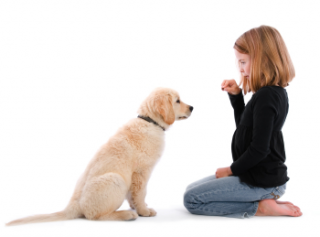
All you need to train your puppy is the inclination, a few sparks in your brain, a couple of pieces of kibble in your hand, and...the puppy. So, enough said — let's get going. Ask your pup whether it is ready to proceed by moving a food lure up and down in front of his nose. If your puppy nods in agreement, you're off and running.
If your pup does not follow the kibble with his nose, use something more enticing for the meantime, such as a favorite chewtoy, or tug toy. But then make sure you teach your puppy to work for kibble. You may not need food lures and rewards to train your puppy, but family, friends and visitors and especially, children and men will need the help of food lures and food rewards. (In fact, I suggest you give children freeze-dried liver to use when training the puppy.) Weigh out your puppy’s daily ration of kibble each morning and place it in a jar to use for training throughout the day. Do not waste valuable training lures and rewards by feeding your dog from a bowl. Handfeed your dog. Once your dog is well behaved and mannerly and perfect for you, you may feed your dog when and however you like. For the meantime though, use each piece of kibble as a food lure and handfeed it as a food reward.
Strive for a really brilliant performance, not just a lackluster attempt. Use a variety of rewards (like a slot machine), and let the value of each reward reflect the quality of your pup's responses. Praise your puppy only for above average responses. Give praise and a piece of kibble for good responses, give praise and freeze-dried liver for better responses, and save the very best rewards (jackpots) — maybe a game of tug, or a snuggle on the couch — for the very best responses. By rewarding your pup differently according to the standard of its responses, you'll find your pup's performance will continue to improve from day to day.
Sit, Stand & Down
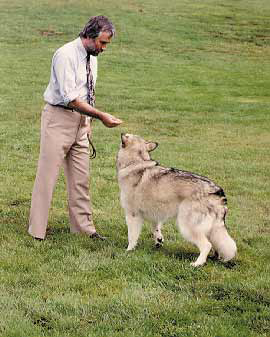
Sit
1. Say "Joe Pup, Sit." 2. Keeping the lure close to your puppy's nose, slowly move it upwards and backwards over the pup's muzzle towards his eyes. As your pup lifts his nose to follow the treat, he will sit down. (Do not lift your hand too high or your puppy will jump up.) 3. As soon as your puppy sits, say "Good little doggie!" and offer a piece of kibble as a reward.
But what did Joe Pup actually learn? Have you taught your puppy to sit? Well, not really. Your puppy knew how to sit when he was only three or four weeks old. More specifically, you have taught your puppy to sit on request. We are not so much concerned if and when your puppy decides to sit of his own accord, but rather, that he sits when requested to do so. Also, you have taught your pup to sit on request only when he was already standing. For your puppy to respond reliably, he must additionally be taught to sit when he is lying down, and to sit from any other body position and activity. Thus, when teaching just three basic body positions — sit, down and stand — the first step is to teach six separate changes of body position: to sit when standing and lying down; to lie down when sitting or standing; and to stand up when sitting or lying down.
Sit from Down 1. Say "Joe Pup, Sit." 2. Hold the lure (palm upwards) in front your pup's nose and then quickly raise the lure upwards and backwards over the pup's head. You may need to waggle the lure or clap your hands over your pup's head to energize him to sit up. If your pup has rolled over to recline on his back, take one step backwards, bend down, and pat the ground in front of his nose. When your puppy rolls back into the Sphinx position in preparation to get up, step in quickly and lure him to sit. 3 When your pup resumes sitting, praise enthusiastically and maybe offer a food reward if he sat up quickly.
Down from Sit 1. Say "Joe Pup, Down." 2. Waggle the lure in front your pup's nose. Quickly lower it to the ground between the pup's forepaws and hold it there palm downwards. Wait for your pup to lie down. Be patient. Inching the lure away from the pup's forepaws may facilitate the process as your pup reaches forward with his nose. Alternatively, slowly move the lure towards your pup's chest to cause the pup's rear end to plop down. 3. When your puppy lies down, say "Good little doggie" and maybe offer a food reward if he lies down promptly.
Down from Stand 1. Say "Joe Pup, Down." 2. Quickly lower the lure all the way to the ground and hold it palm down between the pup's forepaws. This position change is the hardest and so hold your hand steady until the puppy lies down. Once the pup's elbows and sternum touch the ground and the pup assumes a playbow posture, move the lure towards the puppy's chest and this will prompt the rear end to plop down. 3. Praise and reward accordingly (bear in mind this exercise is the most difficult). "Goooood Puppy. Good down!"
Alternative Down 1. It can be a bit tricky teaching Down from the Stand. A simple ploy is to lure your dog under a coffee table, or even under your leg. Say "Joe Pup, Down." 2. Waggle the lure to pique your pup's interest 3. As your pup sniffs the lure, slowly move it away from his nose... 4. ... and your pup will lie down to crawl under your leg!
Stand from Sit 1. Say "Joe Pup, Stand." 2. Slowly move the lure parallel to the ground, forward and away from your pup's nose. As the puppy stands, lower the lure a little to get the pup to look down. (If the pup looks up, he will promptly sit again after standing.) Do not lower the lure too far, though; the pup might lie down. 3. Calmly praise and maybe reward the pup to reinforce solid stands. Gently and rhythmically pushing down on the pup's withers helps solidify the stand stay. The firmer you push, the more solid the stay.
Stand from Down 1. Say "Joe Pup, Stand." 2. Move the lure upwards and forwards in front of your pup's nose. Again, if the pup is out for the count, stepping back and tapping the treat on the ground usually re-energizes the pup. 3. Praise and reward the pup on those occasions he stands up promptly.
Quantum Leaps
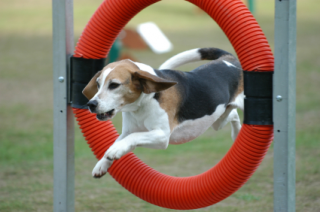
Quantum Leaps You will make four quantum leaps in training as you phase out hand-held training lures, and eventually all training rewards. Phasing out food lures is a simple matter — just put them in your pocket to be used as rewards for above-average responses. Phasing out food rewards is similarly simple — just empty your pockets of food and use something else as a reward.
1. Phasing Out Food Lures As your pup learns to watch the movement of your hand-held lure, your hand movements soon become effective hand signals. Hold your hand palm-upwards for the Sit signal, and palm-downwards for the Down signal. After a few repetitions, your puppy will begin to anticipate each hand lure signal on hearing the relevant verbal command. Thereafter, the verbal request becomes the equivalent of a verbal lure, since it successfully prompts the desired response. Training lures are no longer necessary to entice your puppy into each position because a hand signal or verbal request is sufficient. Put the kibble in your pocket right now. Come on, all of it! Repeat the Sit-Down-Sit-Stand-Down-Stand sequence with empty hands. However, make sure to follow each eager verbal request with a sweeping — nay flourishing — hand signal, just as if you were holding a lure. At the end of the sequence, praise your pup and reward him with a piece of kibble from your pocket. See, you don't need a food lure in your hand to get your dog to respond. Failure was all in your mind, just as the food is now all in your pocket.
This is the first quantum leap: Your puppy has learned that although you have no food in your hand, you can still magically materialize all sorts of goodies from your pocket. Now it's time to begin fading out food rewards.
2. Reducing Food Rewards Go back and use food as a lure for a quick test to see how many puppy-pushups (alternating sits and downs) your pup will do before he gives up. Keep hold of that treat though. The longer your hold on to the lure, the quicker training will proceed. (In fact, that's how we teach stays and "Off!") Now you know how much your puppy is willing to work for the prospect of just one food reward. See which family members and friends can get the puppy to perform the most push-ups for a single food reward. By asking more for less, you have begun to gradually and progressively phase out food rewards in training.
Now repeat the Sit-Down-Sit-Stand-Down-Stand sequence with empty hands but with food rewards in your pocket. Do not be in a hurry to stuff food rewards into your pup's mouth. Instead, treat every food reward as if it were a gold medal. Only reward your pup immediately following extremely rapid, or especially stylish responses.
This is a second quantum leap: Your puppy has learned that although you have food rewards in your pocket, he may not get one every time he responds correctly.
3. Phasing Out Food Rewards Now it is time to empty your pockets and replace food rewards with praise, petting, toys, games, favorite activities, and other luxurious life rewards. This is the third quantum leap: Your puppy has learned that although you have no food rewards in your pocket, even better surprises may follow desired behavior. For example, when walking your puppy, stop and ask him to sit every 25 yards and as a reward say, “Let’s Go” (the walk continues). When in the dog park, call your puppy and ask him to sit every minute or so and as a reward say, “Go Play” (the play session resumes).
4. Phasing Out External Rewards Eventually, it is no longer necessary to reward your dog to reinforce desirable behaviors. Rewarding your dog is always an option and always a wonderful thing to do, but your dog's stellar behavior is no longer dependent on expected rewards. Instead, your dog complies with your requests because he now wants to.
After this fourth quantum leap, external rewards are no longer necessary, since your puppy's good behaviors have become self-reinforcing. In a sense, each correct response becomes its own reward. Really, this is no different from people who enjoy reading, running, riding, playing games and sports, and dancing. Rewards are not necessary. Participation is its own reward.
Stay, Come & Follow
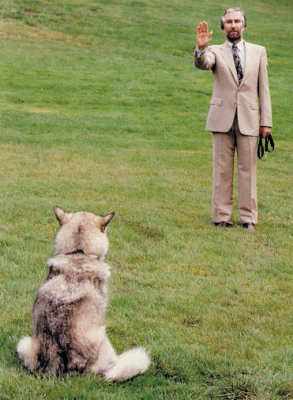
Stay Once your puppy changes body positions quickly and eagerly on request, delay rewarding your pup for a couple of seconds after each position change. Quietly praise your pup while he remains (stays) in the appropriate position. In fact, count out the seconds, "Good sit-stay one... good sit-stay two... good sit-stay three... etc."
Start with easily attainable goals, so your puppy can succeed. For example, three seconds for a Mastiff puppy, and just one second for a wriggly Labrador. And for toy breeds and terriers, the deal is easier yet — if you stay still for just a fraction of a second, frozen in time for a palpable moment — then you'll get a food reward. Next time try for a quarter of a second, then half a second, then a full second, then two seconds, three, five, eight, ten, fifteen seconds, and in no time at all, your puppy's stays will be measured in minutes. By gradually increasing the delay before rewarding your puppy on each successive trial, you are progressively increasing the length of the stay and phasing out the need for rewards.
Have competitions within the family to see who can withhold the food reward for the longest time while the puppy stays in each position. Vary the order of three body positions and make up your own sequences. For example, starting with a sitting puppy, instruct it in the sequence Down-Stand-Down-Sit-Stand-Sit. It is important to vary the lengths of stay in each in each position.
Come 1. With somebody holding your puppy, or while your puppy is playing, say "Joe Pup, Come." 2. Open your arms invitingly, waggle the food or toy lure in front of you, and praise your pup enthusiastically all the time he approaches. Remember, your puppy's first step towards you is the most important step to praise. Reward the puppy's first and subsequent steps towards you. 3. Once your puppy is within three to five dog-lengths, instruct your pup to “sit” and give the hand signal to sit with the right hand (palm upwards with food or toy lure enclosed). 4. Tell Joe Pup that you are overjoyed that he has successfully accomplished yet another wonderful and glorious recall. Maybe offer a food treat, or reward the pup with a game with his toy after especially zippy recalls, and then tell Joe Pup to "Go Play."
Whenever your puppy is off-leash, investigating or playing in the yard or park, instruct him to come to you every couple of minutes or so. However, give your puppy a food reward only for one out of every two recalls. Obviously, reward your pup after the faster recalls. If you reward your puppy after every recall, he may not learn that you want him to come quickly. In this exercise we are using food as a lure to entice the pup to come, and as an occasional reward to reinforce the puppy for coming quickly. However, the real rewards are your praise and the words "Go Play." Say nothing after slower recalls. Simply repeat the process. After a few trials your puppy will come so fast that small breeds will be hard to catch, and large breeds will flatten you. Consequently, it is a smart preemptive plan to instruct your pup to sit when he is homing-in and only three to five puppy-lengths away from potential impact.
Follow Let your puppy off-leash only in safe areas, (e.g., indoors, in a fenced yard, or in a dog park). Walk away from your puppy and he will follow you. There are two simple rules to entice your puppy to follow: 1. Keep moving... 2. Away from your puppy.
This may sound simplistic, but try it. I guarantee, in the space of a few seconds, the average three-month-old pup can train an off-leash owner to slow down, walk backwards, pirouette, stand-stay, recall, and follow. Remember, the puppy cannot follow you unless you are going somewhere. And, unless you are moving away from the puppy, you'll most certainly end up following him. That is not the aim of the game. The pup is meant to learn to follow you. And so, move off quickly, and keep moving away from your puppy at all times.
If your puppy tries to improvise when following, and starts to lag or heads off in an alternative direction, alert your pup to his transgression — "Oi! Come along," and dramatically accentuate your puppy's mistake by quickly zooming off in the opposite direction. Your puppy will smartly self-correct as if on a bungee cord. If your puppy slows down, speed up. If your puppy rushes on ahead, slow down, or turn about and run back from where you came. If your pup drifts left, turn right, and if the pup wanders right, turn left and speed up. Praise your pup the instant he starts to catch up.
Your puppy will quickly learn that he cannot divert his attention from you for a single second without you heading off in some new direction. Consequently, your pup will begin to pay attention and follow. For puppies that are too young to be walked on the streets because they have not yet completed their course of immunizations, the following exercises are easily practiced in the house and garden. Get your puppy to follow you inside and outside, upstairs and downstairs, into different rooms, and around tables and chairs. As Pat Parelli might say, preparatory private practice prevents predictable poor performance and problematic pulling predicaments in public places.
Regular, long, off-leash puppy walks (in safe areas) are the secret to calm and controlled on-leash walking. Your puppy needs to develop a centripetal attraction towards you. Your off-leash pup must always feel a gravity-pull towards the most important body in his universe — you. It is essential to develop off-leash owner-gravity before trying to walk your puppy on-leash. If your puppy doesn't walk close to you when off-leash, he will surely pull when on-leash. Pulling is basically an advertisement that your dog does not want to walk by your side, and presumably would not walk by your side if he were not restrained by a leash. Either your puppy considers that investigating the environment is much more interesting than you, or your puppy simply does not enjoy walking by your side because you keep jerking the leash to try to dissuade him from pulling. (By moving ahead and tightening the leash, the puppy reduces the pain of each jerk.)
Owner-gravity (following) exercises are time-sensitive. It is not safe to walk your puppy on public property until he is at least three months old, and by the time the puppy is 18 weeks old, following exercises start to lose effectiveness. Untrained adolescents soon develop doggy interests and would much rather sniff urine and feces, sniff other dog's rear ends, or simply sniff, than walk by their owner's side. It is much easier to teach off-leash following and closeness before your puppy reaches adolescence.
Take long walks and keep moving away from your puppy. Accentuate your pup's unwanted wanderings by smartly moving off in the opposite direction. Should your puppy get too far ahead, hide. Periodically, shout your pup's name. Remain hiding but keep an eye on your pup. Wait for the puppy to find you and then lavish him with praise. It is unlikely that you will be able to hide from your pup more than a couple of times. Perhaps your puppy thinks that he cannot take his eyes of you for a second without you getting lost. During each walk, remember to frequently instruct your pup to sit or settle down by your side. You can lure and reward your off-leash puppy to settle down beside you simply by holding a piece of rope with a stuffed chewtoy tied to the end.
Heel
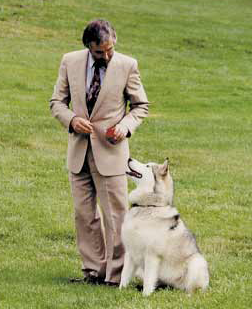
Heel 1. Practice off-leash heeling in a safe area (indoors, or in a fenced yard). Use a lure in your left hand to position the puppy on your left side when in motion, and transfer it to your right hand to signal the puppy to sit when you stop. (Or hold lures in both hands.) With your pup sitting on your left side, say "Joe Pup, Heel" and give a hand signal by moving the lure in your left hand from left to right in front of your dog's nose. 2. Walk briskly forward in a straight line, waggling the lure in your left hand and praising your pup as you go. 3. Transfer the lure from left to right hand in preparation for the sit signal. 4. Say "Joe Pup, Sit," and while in motion, give a sit signal in front of your pup's face with your right hand. 5. Then come to a halt and praise your puppy as soon as he sits: "Good Heel-Sit Joe Pup. Good Heel-Sit." 6. Well, since that was so good, how about a friendly pat of encouragement before proceeding on the next Sit-Heel-Sit sequence.
Teaching your puppy to heel with precision is the most complicated of all training exercises. To make the process as easy as possible, break down heeling into a series of simpler exercises. 1. Teach your puppy to sit quickly and reliably. 2. Teach your puppy to come and sit in heel position. 3. Teach left-, right-, and about-turns in place. 4. Teach straight-line, sit-heel-sit sequences. 5. Combine all the exercises and make turns while in motion.
Before heeling anywhere, make sure that your puppy sits reliably. If your puppy does not sit promptly when requested, you will become frustrated and quickly ruin your pup's desire to heel by repeatedly nagging at your puppy to sit after he heels well.
Teach your puppy precise heel position while stationary. Say, "Puppy, Heel," and use a lure in your right hand to lure your puppy to sit by your left side. Take one step in any direction (forwards, backwards, right, or left), or pivot in place (90˚, 180˚, 270˚, clockwise, or counter-clockwise), and then stand still, say, "Puppy, Heel," and lure your pup to come and sit in heel position again. Repeat this process over and over in a number of different distracting settings — in the house, the yard, and the dog park.
Practice heeling turns in place. Instruct your puppy to sit and then pivot on the spot, using your left-hand food lure to guide your dog around, and your right-hand lure to get your puppy to sit again, facing in the new direction — sit-turn-sit. Practice turning both clockwise and counter-clockwise. Each heeling sequence begins and ends with the dog sitting by your left side. To keep your pup in heel position when in motion requires continual attention and repeated enthusiastic feed-back. Consequently, think of heeling as short sit-heel-sit sequences. Each sit allows you to catch your breath and regain composure.
Make sure you always start each sequence with the pup in the correct position, i.e., sitting by your left side. Use the lure in your right hand to position the pup by your left side. Say "Joe Pup, Sit," and give a hand signal by moving your right hand across your body — upwards and backwards in front of the dog's nose. Transfer the lure to your left hand in preparation for heeling. 1. Establish your composure with your pup sitting in heel position. 2. Heel rapidly in a straight line for a very short distance. 3. Have your pup sit again to re-establish your composure.
For turbo-pups, maybe start with single-step sequences. Your pup will pay much more attention after a series of short, staccato sit-step-sit sequences. Now try for two steps between sits. Then try three, five, eight, and ten steps at a time. Repeat the short heeling sequences, gradually increasing the number of steps between sits. Soon you will be doing long straightaway heels.
Initially, walk as quickly as possible so that your puppy has to walk a straight line in order to keep up. If you amble along, your puppy will have ample opportunity to serpentine from side to side. Initially, heel only in a straight line. Keep your puppy's attention by frequently changing pace. Say "Quickly" before speeding up, and say "Steady" before slowing down. Your pup will quickly learn the meaning of these two very useful instructions. Remember to make it fun. Praise your puppy frequently, and occasionally dispense a food reward after an exceptionally good bit of heeling, or after a stylish, or lickety-split sit.
When you are ready to turn, instruct your puppy to sit, and then turn in place — sit-turn-sit. Then heel away in a straight line in the new direction. After no time, you will be able to begin negotiating turns while moving.
Moving Right Turns 1. To avoid your dog taking a shortcut behind you on right turns, say "Quickly!" 2. Move your left hand forwards to speed up your pup so that his head is in front of your left knee before you turn right. Speed up to encourage your puppy to complete the turn quickly. 3. After the right or right-about turn praise the puppy when he comes back into heel position.
Moving Left Turns 1. To avoid bumping your puppy when making left turns, say "Steady!" 2. Slow down and move your left hand behind your left knee to slow down the pup. 3. After the left or left-about turn, praise the puppy when he comes back into heel position.
Ultra Super Sit
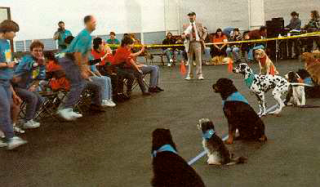
Four Steps to an Emergency Distance Sit With a little practice you can develop and absolutely rock-solid, long-distance, sit-stay that can save you from most dangerous or embarrassing situations your dog could get into. The secret to off-leash control is to thoroughly integrate fun training into all of your dog's off-leash activities. Total integration of training and play should be your aim from the very start. Interrupt your dog's off-leash activities every minute or so. Every time you interrupt an enjoyable activity by instructing your dog to sit, for example, and then allow him to resume the activity, you are reinforcing the dog's prompt sit with a powerful reward. The more you interrupt your dog's play, the more you may reward him for sitting promptly.
First practice the following exercises in safe, enclosed areas. This can be when your puppy is off-leash in your house or yard, when he is playing in puppy classes, during puppy parties, or when off-leash in dog parks.
1. Every minute or so, run up to your puppy and take him by the collar. Praise the pup, offer a tasty food treat, and then tell him to go play again. At first try this in a fairly small area, such as your kitchen with no other distractions. Then try it with just one other puppy present. If you have difficulty catching your pup, have the other owner grab hers at the same time. Then try with a couple of other puppies present. Gradually increase the number of puppies and size of the area until your puppy is easy to catch when playing, for example, in your fenced yard. Use freeze-dried liver treats during this first exercise so your pup quickly comes to love having his collar grabbed.
2. Once your puppy is easy to catch, dry kibble will suffice. Now, instruct your puppy to sit each time after you take him by the collar. Use the food to lure the puppy into a sitting position, praise the pup as soon as he sits, offer the piece of kibble as reward, and then tell him to go play.
3. By now your puppy should feel completely at ease with your running up to reach for his collar. In fact, he probably looks forward to it, knowing he will receive a food reward before resuming play. You may find your puppy sits in anticipation of the food reward. This is good, because the next step is to instruct your puppy to sit before you reach for his collar. Run up to your puppy and waggle a piece of kibble under his nose, and once the puppy homes in on the food, use it as a lure to entice him to sit. Praise your puppy as soon as he sits, offer the kibble as a reward, and tell the puppy to go play. It is vital that you do not touch the puppy before he sits. Some owners are impatient and physically sit the dog down. If you have to rely on physical contact to get your dog to sit, you'll never have reliable off-leash distance control. If you are experiencing difficulties, go back to using freeze-dried liver.
4. Now that your puppy sits promptly as you approach, you can teach him to sit from a distance. Again try this exercise around the house without distractions before trying it with other puppies present. Sit in a chair and without moving a muscle, calmly and quietly say, "Puppy, Sit." Wait a second, then rush toward the puppy saying, "Sit! Sit! Sit!" in an urgent tone but without shouting. Praise your puppy the moment he sits, take him by the collar and let him sniff the kibble. Then quickly take one step backwards, and instruct your puppy to “Come” and “Sit.” If your puppy sits promptly, offer the piece of kibble as reward and then let him resume playing. As you repeat this over and over again, you'll discover that fewer and fewer repetitions of the instruction to sit are necessary before your puppy complies. Also, with repeated trials your puppy sits sooner and sooner and with you farther and farther away. Eventually your dog will sit promptly at a distance following a single softly spoken request.
From now on, whenever your dog is off-leash, repeatedly and frequently interrupt his activity with numerous short training interludes. Ninety percent of the training interludes should be as short as one second. Tell your dog to sit and then immediately say, "Go play." Your dog's quick sit is proof that you have control, so you needn't push it. You needn't prolong the sit stay. Instead, quickly tell your dog to go play so as to reinforce the quick sit. In one out of ten training interludes practice something a little different. Once your dog sits, instruct him to sit-stay or to down-stay. Or walk up to your dog and take him by the collar before telling him to resume playing.